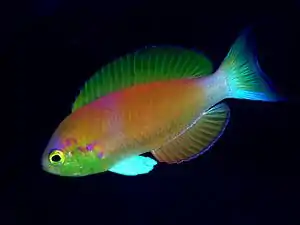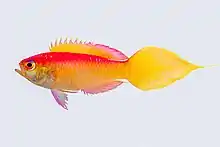Glanzbarsche
Die Glanzbarsche (Callanthiidae (Gr.: kallos = schön, anthias = ein Fisch)) sind eine Familie der Barschverwandten (Percomorphaceae). Sie kommt im Indischen Ozean, im Pazifik, im östlichen Atlantik und im Mittelmeer in Tiefen von 15 bis 500 Metern vor.
| Glanzbarsche | ||||||||||||
|---|---|---|---|---|---|---|---|---|---|---|---|---|

Callanthias japonicus | ||||||||||||
| Systematik | ||||||||||||
| ||||||||||||
| Wissenschaftlicher Name | ||||||||||||
| Callanthiidae | ||||||||||||
| Ogilby, 1899 |
Merkmale
Glanzbarsche ähneln in Gestalt und Farbenpracht den Fahnenbarschen (Anthiadinae). Die Arten der Gattung Callanthias werden 18 bis 60 cm lang, die der Gattung Grammatonotus acht bis 12,8 cm. Die Fische haben eine einzelne Rückenflosse, die Schwanzflossenform ist variabel. Das Seitenlinienorgan verläuft entlang der Basis der Rückenflosse und endet am Ende der Rückenflosse oder auf dem Schwanzflossenstiel. Die Rückenflosse wird von elf Hartstrahlen und neun bis elf Weichstrahlen gestützt. Entlang der Mitte der Flanken zieht sich eine Reihe von Schuppen, die mit kleinen Gruben versehen sind.
Gattungen und Arten


Es gibt 18 Arten in zwei Gattungen:
- Gattung Callanthias Lowe, 1839[1]
- Callanthias allporti Günther, 1876.
- Callanthias australis Ogilby, 1899.
- Callanthias japonicus Franz, 1910.
- Callanthias legras Smith, 1948.
- Callanthias parini Anderson & Johnson, 1984.
- Callanthias platei Steindachner, 1898.
- Callanthias ruber (Rafinesque, 1810), Typusart
- Callanthias splendens Griffin, 1921.
- Gattung Grammatonotus Gilbert, 1905.[2]
- Grammatonotus ambiortus Prokofiev, 2006.
- Grammatonotus brianne Anderson et al., 2016.[3]
- Grammatonotus crosnieri (Fourmanoir, 1981).
- Grammatonotus lanceolatus (Kotthaus, 1976).
- Grammatonotus laysanus Gilbert, 1905, Typusart
- Grammatonotus macrophthalmus Katayama, Yamamoto & Yamakawa, 1982.
- Grammatonotus pelipels Anderson & Johnson, 2017.[4]
- Grammatonotus roseus (Günther, 1880).
- Grammatonotus surugaensis Katayama, Yamakawa & Suzuki, 1980.
- Grammatonotus xanthostigma Anderson & Johnson, 2017.[4]
Systematik
Die zwei Gattungen der Glanzbarsche wurden ursprünglich den Sägebarschen (Serranidae) zugeordnet. Als eigenständiges Taxon wurden die Glanzbarsche 1899 durch den australischen Zoologen James Douglas Ogilby eingeführt,[5] zunächst aber als Unterfamilie der Sägebarsche. G. David Johnson stellte fest, dass beide Gattungen nicht zu den Sägebarschen gehören können, da ihnen die drei Stacheln auf dem Kiemendeckel, das charakteristische Merkmal dieser Familie, fehlt.[6] Die US-amerikanischen Fischkundler James E. Böhlke und Victor G. Springer stellten die Gattungen Callanthias und Grammatonotus in die Familie der Feenbarsche (Grammatidae).[7][8] Der französische Ichthyologe Pierre Fourmanoir erhob die Glanzbarsche schließlich in den Rang einer eigenständigen Familie.[9] Die Stellung der Glanzbarsche innerhalb der Barschverwandten (Percomorphaceae) ist aber ungewiss und sie werden gegenwärtig keiner Ordnung zugeordnet.[10][11]
Literatur
- Joseph S. Nelson: Fishes of the World, John Wiley & Sons, 2006, ISBN 0-471-25031-7
Einzelnachweise
- William D. Anderson, G. David Johnson und C.C. Baldwin: Review of the splendid perches, Callanthias (Percoidei: Callanthiidae). Januar 2015, Transactions of the American Philosophical Society 105(3):1-138, ISBN 9781606180532
- Masao Katayama, Eiichi Yamamoto und Takeshi Yamakawa (1982): A review of the serranid fish genus Grammatonotus, with description of a new species. Japanese Journal of Ichthyology v. 28 (no. 4): 368-374.
- William D. Anderson, B.D. Greene & L.A. Rocha (2016). Grammatonotus brianne, a new callanthiid fish from Philippine waters, with short accounts of two other Grammatonotus from the Coral Triangle. Zootaxa 4173(3): 289–295. DOI: 10.11646/zootaxa.4173.3.7
- William D. Anderson & G. David Johnson (2017): Two new species of callanthiid fishes of the genus Grammatonotus (Percoidei: Callanthiidae) from Pohnpei, western Pacific. Zootaxa 4243(1): 187–194. DOI: 10.11646/zootaxa.4243.1.10
- James Douglas Ogilby (1900): Contribution to Australian ichthyology. The Proceedings of the Linnean Society of New South Wales for the year 1899, 24:154-186.
- G. David Johnson: A Primitive Epinepheline Serranid, with Comments on the Monophyly and Intrarelationships of the Serranidae. Copeia, 1983(3), Seite 777–787.
- James E. Böhlke (1960) Comments on serranoid fishes with disjunct laterallines, with the description of a new one from the Bahamas. Notulae Naturae No.330:1-11.
- Victor G. Springer (1982): Pacific plate biogeography, with special reference to shore fishes. Smithsonian Contributions to Zoology, No.367, iv+182pp.
- Pierre Fourmanoir (1981): Poissons (premiere liste). Resultats des campagnes Musorstom. I Philippines, (März 1976): 85-102
- Glanzbarsche auf Fishbase.org (englisch)
- Ricardo Betancur-R, Edward O. Wiley, Gloria Arratia, Arturo Acero, Nicolas Bailly, Masaki Miya, Guillaume Lecointre und Guillermo Ortí: Phylogenetic classification of bony fishes. BMC Evolutionary Biology, BMC series – Juli 2017, DOI: 10.1186/s12862-017-0958-3